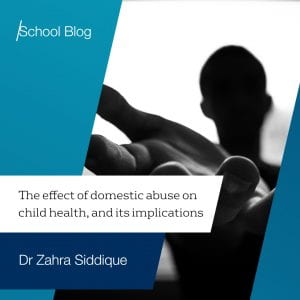 Domestic abuse is widespread and has increased during the Covid-19 pandemic. Apart from the direct costs of abuse to victims, important indirect costs are borne by children of abuse victims for whom we observe increased mortality. This highlights the urgent need to tackle domestic abuse.
Domestic abuse is widespread and has increased during the Covid-19 pandemic. Apart from the direct costs of abuse to victims, important indirect costs are borne by children of abuse victims for whom we observe increased mortality. This highlights the urgent need to tackle domestic abuse.
Dr Zahra Siddique
Domestic abuse is widespread: globally, in 2010, one-third of all women aged 15 or more suffered domestic abuse at some point in their lives. By all accounts, domestic abuse has increased during the Covid-19 pandemic. Lockdown rules, in combination with the financial and social stresses associated with the pandemic, have led to a spike in domestic abuse incidents with victims having few avenues to escape perpetrators.
There are significant direct and indirect costs associated with domestic abuse. Direct costs are costs borne by victims themselves. In extreme situations domestic abuse may lead to female homicides; more generally, there are important physical and mental health costs borne by abuse victims. Apart from these direct costs, there are also important indirect costs of abuse that tend to receive less attention; these are costs borne by other household members, particularly children.
The Demographic and Health Surveys are nationally representative studies of population and health which are compiled using more than 400 surveys carried out in over 90 developing countries. These provide an important source of data on domestic abuse in developing countries.
In our research, we examined data from 54 Demographic and Health surveys carried out in 32 developing countries between 2000 and 2016, which included a questionnaire on domestic abuse. Women aged 18 to 49 were interviewed for the surveys, and fertility histories for these women were collected so that data on all births and deaths of children that respondents have ever had was documented.
We used a sample of approximately 1.3 million children born between 1966 and 2016, investigating the impact of a mother’s abuse on the mortality – or death rate –of their children. Since abuse victims are different from non-victims in several important ways which also matter for child mortality, we controlled for variables such as parent’s education, mother’s age, child gender, birth order, urban location, country and survey year, in our statistical analysis.
After inclusion of controls, we continued to find that children born in families where the mother ever experienced physical domestic abuse were 0.4 percentage points more likely to die within their first 30 days (neonatal mortality), 0.7 percentage points more likely to die within a year (infant mortality), and 1.0 percentage points more likely to die within five years of being born (under-five mortality), compared to children whose mothers did not suffer abuse. These estimates are based on live births and are substantial given that neonatal, infant and under-five mortality rates are 3.0 per cent, 6.2 per cent and 9.2 per cent among non-victims, respectively.
In additional analysis we found that violence experienced in the last 12 months is strongly associated with higher pregnancy loss or stillbirths, suggesting that the true effect on child mortality is potentially even larger than our estimates based on live births would suggest.
Despite controlling for a comprehensive set of variables that capture differences between abuse victims and non-victims which are also related to child mortality, it might still be the case that our estimates are biased due to unobservable differences between the two groups. As a robustness check, we assessed the role of selection on unobservables to estimate lower bounds on the true effect. These continue to indicate economically meaningful positive effects, suggesting selection on unobservables would need to be 2.4-3 times that of selection on observables to nullify our estimated effects.
Whilst our research examined comparable data from across a wide range of developing countries over a fifty-year period, an important question is whether our results also generalise to developed countries (such as the U.K.) where the incidence of domestic abuse tends to be lower. Evidence from studies carried out in the U.S. is strongly suggestive that they do. Aizer (2011) used data on female hospitalizations and birth outcomes for the state of California between 1991 and 2002, finding that serious incidents of domestic violence (where serious is defined as resulting in hospitalisation) caused a reduction in birth weight of 163 grams. Another recent paper by Currie et al. (2020) examined the impact of assaults during pregnancy on infant health outcomes using linked administrative data from New York City, also finding a robust negative effect of assaults on birth outcomes.
The overlooked but important indirect costs of domestic abuse in terms of worse health and mortality outcomes of children born to abuse victims highlights the urgency with which domestic abuse needs to be tackled in the U.K., and across the world.

